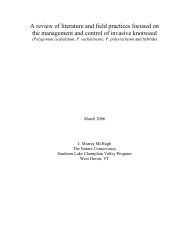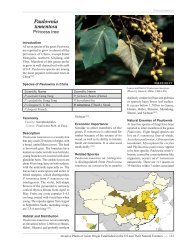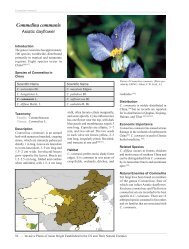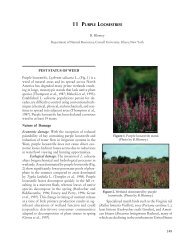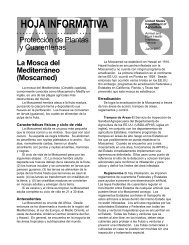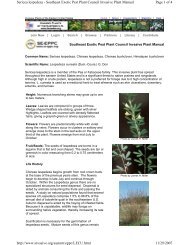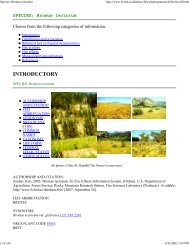Create successful ePaper yourself
Turn your PDF publications into a flip-book with our unique Google optimized e-Paper software.
APHIS<br />
FACTSHEET<br />
••••••••••••••••••••••••<br />
Plant Protection<br />
& Quarantine<br />
United States<br />
Department of<br />
Agriculture<br />
Animal and<br />
Plant Health<br />
Inspection<br />
Service<br />
March 1999<br />
Don’t <strong>Move</strong><br />
<strong>Gypsy</strong> <strong>Moth</strong><br />
Planning to move from an area infested with<br />
gypsy moth to an uninfested area? Moving your<br />
camper or recreational vehicle across border or State<br />
lines? You need to know about a regulation intended<br />
to prevent the spread of this pest.<br />
Recent studies show that most new, isolated<br />
infestations of the gypsy moth were started from egg<br />
masses transported on outdoor household articles—<br />
garbage cans, lawn furniture, children’s toys—any<br />
item accessible to the female moth at egg-laying time.<br />
As a result, the U.S. Department of Agriculture’s<br />
(USDA) gypsy moth quarantine regulations require<br />
that such articles be inspected for all gypsy moth life<br />
stages prior to movement outside of a regulated area.<br />
Why Regulation Is Needed<br />
If you have lived where the gypsy moth is<br />
prevalent, you know the damage these leaf-eating<br />
caterpillars can cause. They defoliate trees and<br />
shrubs, giving summer landscapes a barren, winter<br />
look. <strong>Gypsy</strong> moths can defoliate up to 13 million<br />
acres of trees in 1 season. They crawl on homes,<br />
litter lawn furniture and pools, and make outdoor<br />
activities difficult to enjoy.<br />
Unfortunately, people can unintentionally carry<br />
egg masses with them when they travel, making it<br />
easier for gypsy moths to spread far from their old<br />
neighborhood. Millions of Federal and State tax<br />
dollars have been spent in recent years to limit the<br />
movement of this pest and to eradicate the isolated<br />
infestations established in previously uninfested<br />
areas.<br />
Failure to inspect household articles for gypsy<br />
moth life stages prior to movement from a regulated<br />
area is a violation of USDA quarantine regulations<br />
and may result in significant civil penalties.<br />
Inspecting your property for gypsy moths goes<br />
beyond being a good neighbor: it is required by law.<br />
Don’t be responsible for moving an old pest to a<br />
new neighborhood.<br />
Inspect for <strong>Gypsy</strong> <strong>Moth</strong><br />
You are responsible for making sure that your<br />
outdoor items don’t move the gypsy moth. The<br />
quarantine regulations allow for self-inspection, and<br />
this factsheet can assist you. To do the inspection<br />
yourself, include anything accessible to a gypsy moth.<br />
Inspect any article left outdoors, stored in areas open<br />
to the outside, or stored indoors but used outdoors.<br />
Remember, you are the key to preventing the<br />
movement of gypsy moth on outdoor household<br />
articles, including recreational vehicles. Do your part<br />
to prevent the spread of this pest.<br />
How To Recognize <strong>Gypsy</strong> <strong>Moth</strong> Life<br />
Stages<br />
To inspect your outdoor articles, you need to be<br />
able to identify gypsy moth life stages. Most<br />
important is the egg mass.<br />
The gypsy moth goes through four stages of<br />
development—egg, larva (caterpillar), pupa (cocoon),<br />
and adult (moth). It has one generation per year.<br />
During the summer, female moths attach egg masses<br />
to trees, stones, walls, logs, and other outdoor<br />
objects including outdoor household objects. Each<br />
egg mass contains up to 1,000 eggs and is covered<br />
with buff or yellowish “hairs” from the abdomen of the<br />
female. The velvety egg masses vary in size but<br />
average about 1.5 inches long and .75 inch wide<br />
(roughly between the size of a dime and a quarter).<br />
In the Southern United States, eggs begin<br />
hatching in late March. Eggs start to hatch around<br />
early May in the northernmost United States. The<br />
grayish, hairy caterpillars are easy to identify when<br />
about half-grown by pairs of red and blue dots on<br />
their backs. Mature caterpillars are from 1.5 to 2.5<br />
inches long.<br />
Although they are voracious eaters, caterpillars<br />
stop feeding when they enter the pupal or cocoon<br />
stage, ranging from May in the Southern United<br />
States to early July in the Northern United States,<br />
varying with weather and climate. Adult moths<br />
emerge from the dark-brown pupal cases 10 to 14<br />
days later. Males have light tan to brown wings<br />
marked with dark, wavy bands, and a 1.5-inch<br />
wingspread. Female moths are larger than males
and generally white, with a wingspread of about<br />
2.5 inches. Despite having larger wings, the female<br />
moths cannot fly.<br />
Neither sex feeds in the moth stage; adults mate<br />
and lay eggs only. The eggs are the dormant stage<br />
of the life cycle, allowing the pest to survive winter<br />
weather. Egg-hatch the following spring starts the life<br />
cycle over again.<br />
What To Do If You Find <strong>Gypsy</strong> <strong>Moth</strong> Life<br />
Stages<br />
An effective way to dispose of gypsy moth life<br />
stages is to remove them by hand. Scrape egg<br />
masses from their locations with a putty knife, stiff<br />
brush, or similar handtool. Dispose of egg masses<br />
and other life stages in a container of hot water,<br />
household bleach, ammonia, or kerosene.<br />
<strong>Gypsy</strong> moth hairs, found attached to all life stages,<br />
can cause people who are allergic to them to have<br />
skin rashes or respiratory reactions. If necessary,<br />
wear gloves, protective clothing, and a dust mask.<br />
Additional Information<br />
For more information about the Federal<br />
regulations on moving outdoor household articles,<br />
contact one of the following:<br />
• Your State or Province’s regulatory officials, usually<br />
listed under department of agriculture, plant<br />
protection or regulatory division, in the State or<br />
Provincial government section of your telephone<br />
directory.<br />
• A U.S. Federal regulatory official, listed in the<br />
Federal Government section of your telephone<br />
directory under USDA, APHIS, Plant Protection and<br />
Quarantine. (If you have access to the Internet, point<br />
your browser to http://www.aphis.usda.gov/ppq and<br />
use the “Comments” link to send us an e-mail request<br />
for more information.)<br />
The U.S. Department of Agriculture (USDA) prohibits<br />
discrimination in all its programs and activities on the basis of<br />
race, color, national origin, gender, religion, age, disability,<br />
political beliefs, sexual orientation, or marital or family status.<br />
(Not all prohibited bases apply to all programs.) Persons with<br />
disabilities who require alternative means for communication<br />
of program information (Braille, large print, audiotape, etc.)<br />
should contact USDA’s TARGET Center at (202) 720–2600<br />
(voice and TDD).<br />
To file a complaint of discrimination, write USDA, Director,<br />
Office of Civil Rights, Room 326–W, Whitten Building, 14th<br />
and Independence Avenue, SW, Washington, DC 20250–9410<br />
or call (202) 720–5964 (voice and TDD). USDA is an equal<br />
opportunity provider and employer.<br />
Self-Inspection Checklist<br />
Important: Make sure this checklist goes with<br />
your household goods when you move!<br />
Checklist and Record of Your Self-Inspection<br />
Date:<br />
Place Inspected:<br />
Recreational or Camping Items<br />
❑ Backpacks ❑ Ice chests<br />
❑ Basketball ❑ Motorcycles<br />
backboards ❑ Motor homes<br />
❑ Bicycles<br />
❑ Recreational<br />
❑ Boats<br />
vehicles<br />
❑ Boat trailers ❑ Snowmobiles<br />
❑ Campers<br />
Household Items<br />
❑ Air conditioners<br />
❑ Barrels<br />
❑ Cardboard and<br />
wooden boxes<br />
❑ Clothesline poles<br />
❑ Clothespin bags<br />
❑ Empty plant<br />
containers<br />
❑ Firewood<br />
❑ Houseplants<br />
taken outside<br />
during the<br />
summer<br />
Building Materials<br />
❑ Bricks<br />
❑ Cinder blocks<br />
❑ Cement-mixing<br />
tubs<br />
❑ Lumber<br />
❑ Ladders<br />
❑ Outdoor<br />
doormats<br />
❑ Outdoor<br />
thermometers<br />
❑ Refrigerators<br />
❑ Sheets of plastic<br />
❑ Shutters<br />
❑ Storage sheds<br />
❑ Storm/screen<br />
doors and<br />
windows<br />
❑ Roofing<br />
materials<br />
❑ Sewer pipes<br />
❑ Tools and<br />
toolboxes<br />
Yard and Garden Items<br />
❑ Animal houses ❑ Fencing<br />
(e.g., doghouses, ❑ Fertilizer<br />
rabbit hutches) spreaders<br />
❑ Barbecue grills ❑ Flagpoles<br />
❑ Birdbaths ❑ Garden tillers<br />
❑ Bird feeders ❑ Garden tools<br />
❑ Bird houses ❑ Lawnmowers<br />
❑ Bug lights ❑ Mailboxes<br />
❑ Carts<br />
❑ Picnic tables<br />
❑ Coldframes ❑ Porch or patio<br />
❑ Driftwood<br />
furniture<br />
Children’s Playthings<br />
❑ Bicycles, ❑ Swingsets<br />
tricycles<br />
❑ Tire swings<br />
❑ Playhouses ❑ Wagons<br />
❑ Sandboxes<br />
❑ Sleds, toboggans<br />
Other Items<br />
❑ Car parts<br />
❑ Car ramps<br />
❑ Cars or trucks<br />
❑ Farm items<br />
❑ Plants<br />
Please inspect anything that was stored outside!<br />
Signature:<br />
❑ Sports<br />
equipment<br />
❑ Tarps<br />
❑ Tents<br />
❑ Waders or boots<br />
❑<br />
❑ Tanks for<br />
propane and oil<br />
❑ Television<br />
antennas<br />
❑ Trash cans<br />
❑ Washing<br />
machines<br />
❑ Water hoses<br />
❑ Weather vanes<br />
❑ Window awnings<br />
❑<br />
❑ Water pipes<br />
❑ Welding<br />
equipment<br />
❑ Workbenches<br />
❑<br />
❑ Signs and posts<br />
❑ Snowblowers<br />
❑ Storage sheds<br />
❑ Swimming pools<br />
❑ Trees and<br />
shrubs<br />
❑ Trellises<br />
❑ Wheelbarrows<br />
❑ Yard decorations<br />
❑<br />
❑ Other outside<br />
toys like trucks,<br />
sand molds<br />
❑<br />
❑ Stored tires<br />
(snow tires)<br />
❑


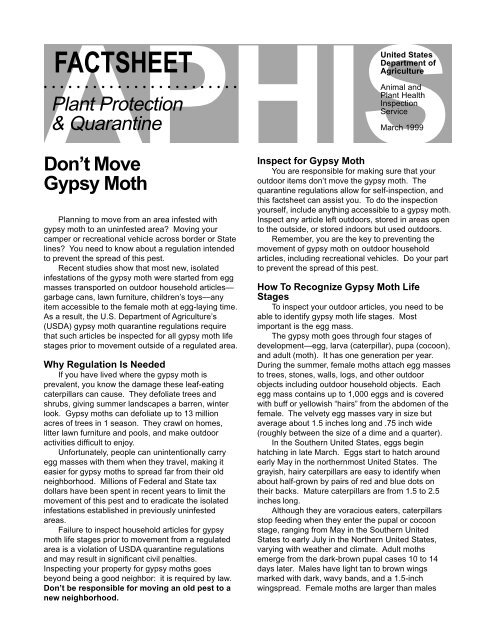

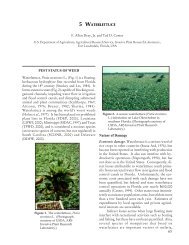

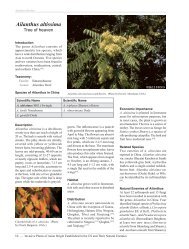
![A Guide to the Control and Management of Invasive Phragmites [PDF]](https://img.yumpu.com/27321025/1/190x190/a-guide-to-the-control-and-management-of-invasive-phragmites-pdf.jpg?quality=85)

